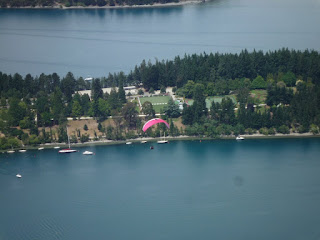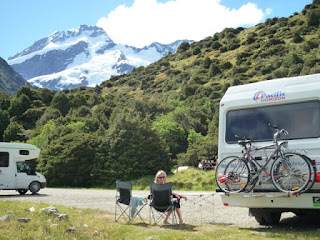NEW ZEALAND.
SOUTH ISLAND 04/12 - 22/12
The flight to Christchurch with Air New Zealand was uneventful, with the best in-flight entertainment so far. If you feel in need of a gin and tonic you order it on your screen and moments later a stewardess appears with your order - brilliant.
We had some difficulty entering the country after Fran fell foul of the NZ Ministry for Ag and Fish for attempting to smuggle a lemon into the country in the handbag. She was eventually released with an official written warning, and is no doubt on an international database and on every county's watch list for potential criminals and troublemakers attempting to cross their borders.
We stayed in a local airport hotel, pre-booked so we are learning, for what remained of the night and then set off the next morning to be acquainted with what was to be our home for the next month – our camper van. And what a fine van she is, having only 2000km on the clock and only one previous rental.
It took about an hour for the nice young girl to explain the intricacies of the electrical supply, operation of fridge (more complicated than you may think), the cooker, the heating system, how to convert from day to night configuration (seats to beds), how to use the loo and shower, etc,etc. Also how to service the van from day to day by topping up the water and dealing with the waste; grey waste from the basins and shower but interestingly no colour attached to lavatory waste. At the mention of the word waste, irrespective of colour, Fran would become pre-occupied with inspecting the cooker or microwave or any thing else she could find. Afterwards she would claim she hadn't heard any instructions about emptying waste and therefore could take no part in the process.
We decided we would spend the first night in Christchurch for two reasons; firstly we wanted to become familiar with our new home without having to travel too far, and secondly we wanted to meet a couple who were selling two bikes they had advertised on the internet. But first we had to go to a supermarket to provision our van, and the nice young girl gave us very clear directions to a big supermarket 2 minutes down the road from the camper van office.
Having said our goodbyes to the nice young girl I rather cautiously took the wheel and our adventure began. I was driving slowly but after about 15 minutes it became obvious we had gone wrong somewhere. I am never one to apportion blame in these situations but perhaps if Fran had spent less time sucking in breath every time I passed within ten feet of an obstacle and more time studying the map we would have found the supermarket in the regulation 2 minutes. I must confess to a moment of deep depression at this point as I reflected on the 4500km still to go.
We arranged to stay at the same camp site as the bike couple and, fully provisioned, duly arrived and set our van up for the overnight stay desperately trying to remember everything the nice young girl had said. Having got it powered up and made it shipshape we decided to sit outside in the sun in our two deckchairs at our picnic table. These we had hired as an extra from the camper van people and, being collapsible, were contained in their own long, narrow nylon bags. This was an area the nice young girl had overlooked and the chairs were a bit of a challenge, but after a casual stroll past a couple of pitches where similar chairs were deployed, and surreptitiously studying how they were locked in position, it was no problem. However as soon as I had emptied the table bag of its contents I knew we were in trouble. Fortunately the bike people had not yet arrived but they were expected at any moment. A quick look around nearby pitches confirmed no-one else was using such a fiendishly complicated design of table so we were on our own. After an incredibly intense brain storming session we proved that synergy really works (I finally realized what those ridiculous management training exercises were for) and by the time the bike people arrived we were sitting on our chairs with the table supporting two glasses of wine as steady as a rock.
The couple turned out to be David and Pauline from Oldham who were completing 4 weeks travelling from Auckland to Christchurch, and had bought second hand bikes at the outset. They were our age and we got on very well. We spent the evening together during which time they passed on lots of helpful information from their experiences, and we bought the bikes for about half the cost of renting.
Our newly acquired bikes. Fran is going to have to learn to cope with a crossbar!
It was quite a long and convivial evening and, with the benefit of hindsight, Fran and I should have built our bed before we embarked on the wine we had bought earlier. We thought we had done it right but when we awoke the next morning we found the bed was a most peculiar uneven and irregular shape. After some practice we found it actually became large, flat, square and very comfortable.
The rear of the van in daytime configuration.
Night configuration.
Fran hard at work in her kitchen amidships.
Now you have seen it all!
We tried out the bikes by cycling into the centre of Christchurch. It is a beautiful city with a very small central area around the cathedral. However it was a very sombre occasion as by chance we arrived in Cathedral Square just as a memorial service for the miners killed in the Pike River mine disaster was about to start. It was being broadcast in the square and gradually the numbers grew as people paid their respects in total silence.
The memorial service is about to start - note the big screen to the right of the cathedral.
In addition to this there was also evidence of the recent earthquake, and you really felt that this corner of the world had had its fair share of natural disasters which seemed strangely incongruous for such a pretty place.
A building damaged by the earthquake.
On a lighter note nothing will dampen the excitement about hosting the rugby World Cup in the Autumn.
We did our bit for the earthquake appeal by buying this bottle of wine.
That night we stayed in a field miles from anywhere in pouring rain. We were quite cosy and completely self sufficient in our van but some fellow campers with tents elected to sleep in their cars rather than face the elements under canvas.
Early next morning the rain has stopped and we are about to set off for the mountains.
The drive to the Southern Alps was beautiful with wild lupins lining the road.
Lake Tekapo with the Southern Alps in the background. The water is a striking bright blue, coloured by melt water from the galciers.
Getting closer to the mountains.
Camping close to Mt. Sefton.
Dr Doolittle is at it again.
A memorial to those who have died in the mountains. There are a startling number of these plaques.
The memorial in the foreground with Mt. Cook in the background.
Fran crossing a swing bridge. So called as they swing significantly from side to side as you cross them. I was forbidden to set foot on them until Fran was safely across.
The bridge crossings and trekking were worth it for this view of Mt. Cook.
A lady called Freda du Four became the first woman to climb Mt. Cook in 1910 and afterwards her photo was taken beside the this rock which became known as 'Freda's Rock.'
'Fran's Rock.'
Fran's first go at driving the van as we leave the mountains and she is soon presented with an unusual hazard.........
There are 10 sheep per person in NZ and most of them were being shepherded along this road.
Soon after Fran had successfully negotiated the sheep (I am glad to report there are still 10 sheep per person in NZ) we came across a gliding site just south of the mountains in a place called Omarama . Just out of curiosity we stopped and I had a chat with one of the instructors and soon learned that, because of its proximity to the mountains and local weather phenomena, this was one of the best gliding sites in the world. He tried to persuade me to go up for an hour and although I thought it was unfair on Fran she joined forces with the instructor and insisted I took the opportunity. I am so pleased she did as it turned out to be one of the highlights of the trip.
The instructor was English, aged about sixty, and a very accomplished glider pilot. He spends the northern summer in the UK instructing at Dunstable and the southern summer instructing at Omarama. What a life! We knew a lot of people in common and got on very well. The flight was brilliant and we managed to climb to about 10,000 feet in thermals after an aerotow to about 2000 feet. The scenery was breathtaking, as was my attempt at landing, and the whole experience has given me some ideas.
Looking apprehensive as I stow the water the instructor insisted I took and wearing the hat he lent me and insisted I wore.
Nearly airborne.
Circling in some rising air. A bit too close to the mountain for my liking as I spend my professional life keeping as far away from them as possible. (Forget the sophisticated instruments, the length of wool stuck onto the outside of the canopy just above the compass is used to indicate what rudder input is required)
The views at altitude were stunning.
At this point the landing is looking good - just prior to a rather heavy impact with the ground.






























































